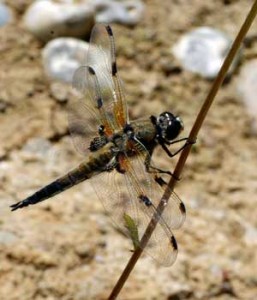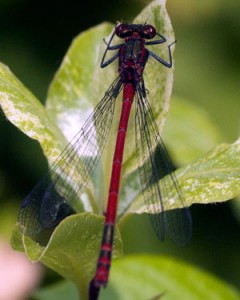Dragonflies and Damselflies…….

The trend in the weather since the 1980’s has been for a general increase in temperature. Perhaps, in consequence, new species of dragonfly and damselfly have arrived in Britain from the warmer climates of Southern Europe.
The following species have been recorded to date
- the Willow Emerald
- the Southern Migrant Hawker
- the Southern Emerald Damselfly
- the Vagrant Emperor
- the Small red-eyed Damselfly and
- the Dainty Damselfly.
The Dainty Damselfly was declared extinct in the UK, after the floods in the winter of 1952 / 53; these penetrated inland from the East Anglian coast destroying many delicate habitats.  However, a few individuals were discovered in 2010 at a site in north Kent. They probably crossed the channel from Belgium or France, perhaps aided by a suitable breeze. Damselflies (in general) are not such strong fliers as dragonflies. Whether a stable breeding population will be able to establish itself is not yet known; some of the very low temperatures this last winter may make this less likely.
However, a few individuals were discovered in 2010 at a site in north Kent. They probably crossed the channel from Belgium or France, perhaps aided by a suitable breeze. Damselflies (in general) are not such strong fliers as dragonflies. Whether a stable breeding population will be able to establish itself is not yet known; some of the very low temperatures this last winter may make this less likely.
One piece of evidence of a breeding population is the presence of ‘exuviae’ ; these are discarded larval casings or exoskeletons. Insects can grow in the period immediately after the shedding of the exoskeleton (ecydysis) as the new skeleton (that has formed underneath the old one) is soft and pliant; however, at this time the animal is also vulnerable to predators.
The small red eyed damselfly is now well established in much of south east England, having first appeared in 1999. The willow emerald was recently seen along the Suffolk coast (having previously been seen but regarded as an occasional migrant); its population(s) is now being monitored – some excellent images of this damselfly can be seen here.
 Damselflies are generally smaller than dragonflies, and not as strong at flying, so are usually found near water / water margins. They have two pairs of roughly equal sized wings. When at rest, their wings are usually positioned along the backs, whereas those of dragonflies tend to be extended at right angles to the body (see featured image above). Adult dragonflies have two (unequal) pairs of wings, which enable them to hover or fly in any direction.
Damselflies are generally smaller than dragonflies, and not as strong at flying, so are usually found near water / water margins. They have two pairs of roughly equal sized wings. When at rest, their wings are usually positioned along the backs, whereas those of dragonflies tend to be extended at right angles to the body (see featured image above). Adult dragonflies have two (unequal) pairs of wings, which enable them to hover or fly in any direction.
The ‘new’ damselflies and dragonflies may be doing well, but some existing dragonflies species are struggling – mainly through loss of habitat; there are about 30 species of dragonfly presently in the UK. Dragonflies need wet places as their larval forms or nymphs remain aquatic (living in ponds or slow flowing streams) for months or even years. One ‘solution’ to this has been to flood old gravel pits, open cast mines and quarries – thereby creating ‘instant aquatic homes’ for a variety of animals from newts to dragonflies. One such example is Brockholes Wetland, in Lancashire which has been created out of a disused gravel quarry. Other efforts to help dragonfly populations include the ‘rehoming’ of dragonfly eggs and nymphs (of the White faced Darter), such as that undertaken at Foulshaw Moss nature reserve in Cumbria – details can be found here .
Comments are closed for this post.
